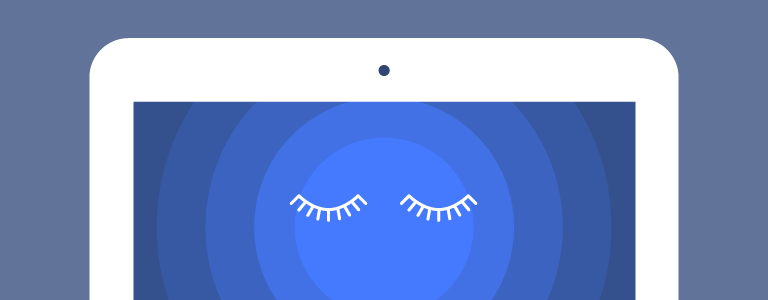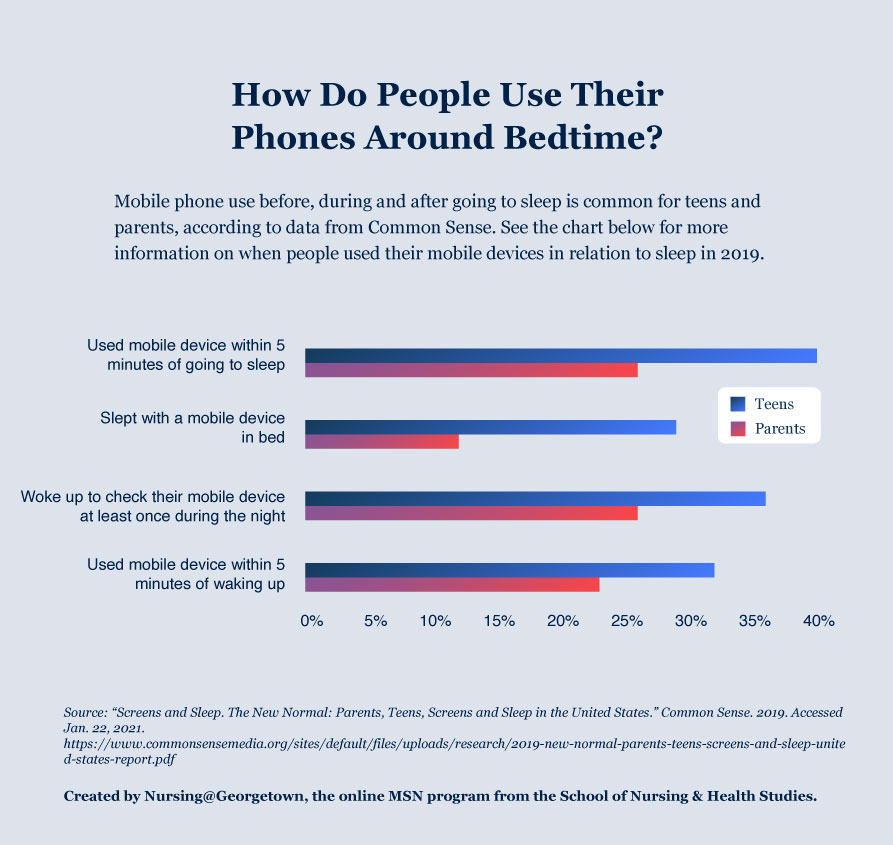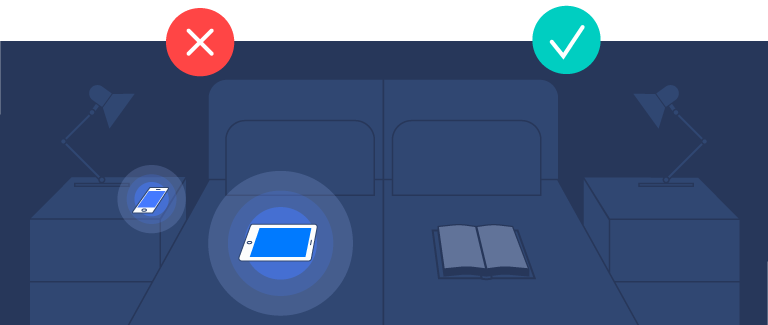Sleeping Well in the Digital Age

Hours spent in front of screens while working from home, learning remotely, and socializing from afar have become hallmarks of the COVID-19 pandemic. Add that to the excessive time people were already spending on smartphones, computer monitors, and televisions, and it’s not surprising that screen time has skyrocketed.
irregular sleeping patterns are harmful to our health, and one culprit is the amount of time people spend looking at screens. That behavior disrupts our quality of sleep, which in turn negatively affects circadian rhythms — the internal clocks that regulate behavior, hormone levels, sleep, body temperature, and metabolism.
Reducing screen time before turning in for the night has never been more important, and the expert recommendations below may help.
Approximately 61 percent of American parents and 70 percent of children use their mobile devices within 30 minutes of falling asleep at night, according to a 2019 Common Sense Media survey (PDF, 1.8MB).

In 2019, 40 percent of teens and 26 percent of parents used their mobile devices within five minutes of going to sleep, 29 percent of teens and 12 percent of parents slept with a mobile device in bed, 36 percent of teens and 26 percent of adults woke up at least once during the night to check their mobile devices, and 32% of teens and 23% of parents used their mobile devices within five minutes of waking up.]
Excessive screen time — the time we spend interacting with smartphones, televisions, tablets, laptops, and other digital devices — not only affects us in the moment but also impacts the quality of our sleep, causing a host of other physical and mental health problems.
The Link Between Light and the Brain
Our circadian rhythm determines when we feel sleepy or awake. These rhythms — which average 24.25 hours long — are affected by environmental cues, the most powerful of which are the rising and setting of the sun.
Different types of light also affect our circadian rhythm.

Short-wavelength blue light
- Sources: the sun, LED lights, tablets, e-readers, computers, cellphones
- Sparks cortisol production, which helps us stay alert and suppresses melatonin, which helps us fall asleep.

Long-wavelength red light
- Sources: firelight, lanterns, candles, torches
- Has the least power to suppress melatonin production and thus has less of an impact on whether we feel tired or awake.
Timing Is Everything

Blue light is not bad; in fact, it is essential during the day. However, excessive exposure at night has shown to have negative effects on our health.
Short-term use of screens before bed
- Delays time it takes to fall asleep by an average of about 10 minutes.
- Reduces REM sleep — which plays an important role in learning and memory function — by 10 percent.
- Reduces morning alertness and increases the amount of time — by hours — it takes to fully wake up.
Long-term use of screens before bed increases the risks of
- Insomnia, which involves consistent problems falling or staying asleep.
- Delayed sleep-phase disorder, which causes people to fall asleep and wake up much later than is considered normal.
- Chronic sleep deficiency, which happens when an adult regularly gets less than seven to nine hours per night.
These conditions can lead to chronic behavior, performance, and health issues. They can also increase the risks of breast cancer, colorectal cancer, and prostate cancer.
Sleep and Mental Health: A Two-Way Street
Sleep and mental health are also intertwined, and sleep deprivation can worsen mental health problems. Poor sleep goes hand-in-hand with mental health problems, including:
- ADHD
- Depression
- Anxiety disorders
- Bipolar disorder
- Seasonal affective disorder
- Memory impairment
- Schizophrenia
While poor sleep can worsen some mental health conditions, mental health problems can also lead to a lack of sleep and issues like insomnia. Sleep disorders are more likely to affect those with psychiatric disorders, and treating sleep disorders and getting proper sleep may help ease mental health issues.
Separating Sleep Time From Screen Time

Ensuring that screens don’t stifle your ability to get enough high-quality sleep is easy, but requires planning. The Sleep Foundation offers the following tips:
- Create a technology-free bedroom.
- Decrease your screen time during the day and the night.
- Don’t work in bed.
- Avoid looking at screens two to three hours before going to bed and establish a bedtime routine that does not include electronic devices.
- Keep screens out of the bedroom and reduce light as much as possible.
- Read printed books rather than e-readers, tablets, or computers.
- If you must use a screen in the bedroom, dim the brightness on your device, use “nighttime mode” on your device, or wear blue-blocking glasses.
Tips for Parents to Limit Screen Time for Children
The American Academy of Pediatrics advises against children younger than 18 to 24 months using most media and suggests limiting screen time to one hour daily for children ages two to five. Because COVID-19 has increased screen use among children, families should monitor and set ground rules for their children’s screen time, according to research in the Journal of Pediatric Nursing. Pediatric nurses can help educate parents and caregivers on appropriate screen time for their children.
The Mayo Clinic recommends these best practices for limiting screen time for children:
- Preview shows, games, and apps before your child views or uses them.
- Seek interactive gaming options that engage your child rather than those that just require pushing and swiping or staring at a screen.
- Use parental controls to block or filter internet content.
- Supervise your child’s activities during screen time.
- Ask your child regularly what programs, games, and apps he or she has engaged with.
- Watch, play, or use shows, apps, and games with your child and discuss what you’re watching with them.
And these guidelines can help parents manage screen time for for older children:
- Prioritize unplugged, unstructured playtime.
- Discourage use of media entertainment during homework.
- Eliminate background television.
- Create tech-free zones or time periods, such as during mealtime.
- Set and enforce daily or weekly screen time limits and curfews.
- Keep screens out of your child’s bedroom and require your children to charge electronic devices outside their bedroom at night.
- Model the behavior by limiting your own screen time.
Apps can also be helpful for tracking and limiting screen time across devices. Some apps that may help parents monitor and manage screen time include:
Additional Resources
These websites offer additional information and tips around screen time and healthy sleep habits.
- American Academy of Pediatrics: Media and Children Communication Toolkit
- American Academy of Pediatrics: Family Media Plan
- American Nurse: Nurses offer strategies to promote patients’ rest and sleep
- American Nurse: Tips for achieving healthy sleep
- American Sleep Apnea Association: Could nurses help patients “connect the dots” between sleep and wellness?
- Atlanta Journal-Constitution: 5 better sleep tips from a sleep clinic nurse practitioner
- National Sleep Foundation: How to Design the Perfect Bedtime Routine
- New Jersey State Nursing Association/Institute for Nursing: Healthy Sleep (PDF, 121KB)
- Screen Time vs. Dream Time: 11 Tips for Promoting Healthy Sleep Habits During COVID-19
- SleepFoundation.org: Healthy Sleep Tips
- SleepFoundation.org: How Electronics Affect Sleep
- Youth Screen Media Habits and Sleep: Sleep-Friendly Screen Behavior Recommendations for Clinicians, Educators, and Parents
Please note that this article is for informational purposes only. Individuals should consult their health care provider before following any of the information provided.
Citation for this content: Nursing@Georgetown, the online MSN program from the School of Nursing & Health Studies


